Gun Tests subscriber, Reader Nick G., sent us a note a while ago asking us about different gas plugs for the Garand that are available on the market now. His note said in part: “I have been a subscriber for a long time. I would like to see a test of the available options for M1 Garand gas plugs that allow shooting commercial ammo. Surplus Garand ammo is harder to find and more expensive than ever. There are some of these plugs that are adjustable and appear to bleed off gas pressures, while others have a cavity in the rear of the gas plug. I would like to see a comparison test of these gas plugs.”
Our research found two, with the first being in the form of a gas plug available from Garand Gear (GarandGear.com, $48.50). The second was an adjustable plug from Schuster Manufacturing, Inc. (SchusterMfg.com, $52). Of course, the third plug came with the rifle and became our control for gauging how the two replacements worked.
To see how these gas plugs functioned, we used some older Remington 150-grain Core-Lokt rounds from MidwayUSA.com and some carefully assembled reloads using the recommended IMR 4895 powder, CCI Large Rifle Primers and Remington brass. We used three different types of bullets in the reloads, all of which we thought were specifically suitable to our application. Those were the Hornady 150-grain FMJ, Sierra 155-grain Palma Match HPBT, and Sierra 155-grain Tipped Match King.
History
Garands were the shoulder arms for many of the greatest generation. That means a few of you carried this 9-pound 2-ounce rifle though parts of Europe and Africa, perhaps the length and breadth of the Pacific. We salute you. For some of us, it was our fathers or our grandfathers who served. Our test group wondered how many of the Gun Tests readership grew up running around their neighborhoods with play rifles, hoping that we could be as brave as them. No less a personage than General George S. Patton called the M1 Garand “the greatest battle implement ever devised.”
 Designed by Canadian-born John Garand (our sources tell us his name should be pronounced as rhyming with “errand,” not “guh-RAND”), the M1 was adopted by the U.S. Army in 1936, accepted in 1938, and production really got rolling in 1940. Data from those early days shows production to be right at 100 rifles per month. By January 1944, those numbers peaked near 165 rifles per hour. Thanks to Mr. Garand and all those who worked with him at Springfield Armory, the U.S. military was able to arm itself with a full-caliber (30-06 Springfield) semi-automatic battle rifle when most of the warring nations were still equipped with bolt-action rifles. Germany and Russia were both able to field their own semi-autos, but not in anything remotely approaching the quantities enjoyed by the U.S. Our soldiers and Marines clearly had the advantage in individual firepower.
Designed by Canadian-born John Garand (our sources tell us his name should be pronounced as rhyming with “errand,” not “guh-RAND”), the M1 was adopted by the U.S. Army in 1936, accepted in 1938, and production really got rolling in 1940. Data from those early days shows production to be right at 100 rifles per month. By January 1944, those numbers peaked near 165 rifles per hour. Thanks to Mr. Garand and all those who worked with him at Springfield Armory, the U.S. military was able to arm itself with a full-caliber (30-06 Springfield) semi-automatic battle rifle when most of the warring nations were still equipped with bolt-action rifles. Germany and Russia were both able to field their own semi-autos, but not in anything remotely approaching the quantities enjoyed by the U.S. Our soldiers and Marines clearly had the advantage in individual firepower.
As adopted, the M1 Garand is a true gas-operated semi-automatic rifle firing a single round with each press of the trigger. Some of the expanding gases from the ignition of the cartridge are allowed to escape through a port on the bottom of the barrel just over 1.5 inches to the rear of the muzzle. Those gases impinge on a long operating rod, which also acts as a piston. This almost 24-inch-long op-rod is attached to a stud on a rotating bolt. As the op-rod moves to the rear, it forces the bolt to the rear, as well ejecting the empty cartridge in its travel and then feeding a new cartridge as the bolt moves forward. Press the trigger and the process begins anew.
More than 4 million of these rifles were produced. Many did not survive the war or are stashed away now in some forgotten lend-lease warehouse, but substantial numbers made it back home to Americans who like a piece of history. Only a few are true collectors’ items. The rest are just great shooters. Therein lies a problem. The Garand was engineered to operate in a specific pressure range and is less forgiving than most designs. Current max loads on modern 30-06 rifle cartridges can frequently tickle 60,000 pounds per square in (psi), and the Garand was designed to operate at around 50,000 psi. Note: If you reload for this rifle, please make sure of the measurement you are using. We are listing maximum-pressure numbers in pounds per square inch. Another metric, copper units of pressure, or CUPs, is sometimes referenced, and that number should be much lower — more in the 40,000 CUPs range. Using modern 60,000-psi high-pressure ammo can overpressure the Garand’s operating rod, causing it to bend. One can still find replacement op-rods online, but like anything else where production stopped in the 1950s, replacement parts are becoming more scarce and more expensive.
Our test rifle is a Springfield Armory M1 Garand manufactured in March 1943, as determined by serial number. This rifle was obtained through the Director of Civilian Marksmanship (now the CMP or Civilian Marksmanship Program) more than 25 years ago. It does not show any stamp suggesting it has been imported back into the USA after foreign service in some other country. Nor does it bear any stamps we can find indicating a rebuild. Overall condition is excellent, with an almost spotless bore and diameter at the muzzle only 0.001 inch over nominal. The front sight and the gas tube are nice and tight, as is the rear sight. Original Parkerizing appears to be in good shape, with no rust or pitting visible. This one’s a keeper.
DCM M1 Garand
Gun Tests Grade: A
$450+
DCM M1 Garand 30-06 Springfield
The M1 Garand is an incredible piece of history. For those wishing to buy their own piece of history, check out the Civilian Marksmanship Program at TheCMP.org.| Action Type | Semi-auto |
| Overall Length | 43.5 in. |
| Barrel Length/Twist | 24 in., 1:10 |
| Overall Height w/o Scope Mount | 6.2 in. |
| Weight Unloaded | 9.1 lbs. |
| Weight Loaded (150 grain, 8 rounds) | 9.6 lbs. |
| Sight Radius | 27.9 in. |
| Action Finish | Parkerized |
| Barrel Finish | Parkerized |
| Magazine Capacity | 8 |
| Magazine Type | Internal fed by 8 round en-bloc clips |
| Stock | Walnut |
| Drop at Comb | 1.0 in. |
| Drop at Heel | 1.4 in. |
| Bedding | None |
| Buttplate | Steel |
| Length of Pull | 13.2 in. |
| Receiver Scope-Base Pattern | NA |
| Trigger Pull Weight | 1.9 lbs. |
| Safety | Pivoting latch in front of trigger guard |
| Warranty | None written |
| Telephone | (419) 635-2141 |
Pressure Worries
We’ve covered the Garands several times, and subscribers can find those articles easily by typing in “Garand” in the search window of the Gun-Tests.com website. Regarding tests of older Garands, Reader Dwight had written in to say, “I would like to caution your readers NOT to reload or use bullets over 180 grains in the Garand rifle. Heavy bullets can and will cause high pressure and could bend/distort the operating rod and further damage the rifle. As a former National Guard armorer (graduate of the U.S. Army small arms school in Aberdeen, MD) we were advised of this danger. At this time we were transitioning from the M1 Garand to the M16 rifle, but a number of M1s were still being used for competition and general shooting.”
Also, Reader Dan wrote, “I received a warning from CMP on Monday stating that 30-06 ammunition with a bullet weight over 172 grains should not be fired in 03 Springfield, 03-A3 or Garand rifles.”
That April 20, 2021, Civilian Marksmanship Program (CMP) email Dan referred to said in the subject line, “WARNING – .30/06 Ammo – Revision,” and then read, “Dear CMP Family, The CMP advises to not use .30/06 ammunition in M1 Garands, 1903s, and 1903A3s that is loaded beyond 50,000 CUP and has a bullet weight more than 172-174gr. These rifles are at least 70 years old and were not designed for max loads and super heavy bullets. Always wear hearing and eye protection when firing an M1 Garand, 1903 and/or 1903A3 rifle. This warning is an update/addition to the Ammunition section in the Read This First manual enclosed with each rifle shipment (M1 Garand manual-page 6 and M1903 manual-page 10).”
What are your options for shooting the M1 Garand then? Option One is to buy ammo loaded specifically for the M1. Federal, Hornady, and PRVI Partizan are all reported to manufacture such loads. Mil-Spec M2 ball 30-06 ammo is also still available, although getting harder to find.
Option Two is to reload, using powders with a burn rate suited for the Garand, with IMR 4895 (available through Hodgdon) perhaps being the best example. We see posts claiming good results with similar powders such as H4895, IMR 4064, RL15, Varget, and Vihtavuori N140. Explore the use of these carefully and work up your powder charges slowly.
Is Option Three to use these gas plugs? That’s part of what Reader Nick asked about.
How We Tested
All shooting was done at American Shooting Centers (AMShootcenters.com) on the west side of Houston. The rifles were well supported using a Caldwell TackDriver (MidwayUSA.com, $44) and a large, rear bag (heavy) from Tab Gear (TabGear.com, $30). Out of consideration for the use of iron sights and older eyes, all groups were shot at 50 yards. Velocities were obtained via LabRadar (MyLabRadar.com, $559). Control groups were fired using the factory gas plug, then again with each different replacement plug.
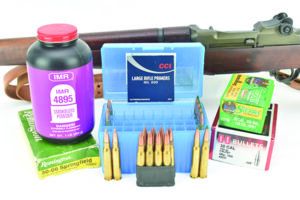
Reader Nick asked us to find out how the plugs would affect velocity, accuracy, and function, along with how difficult they were to use. In a best effort to get him some answers, we fired eight-shot groups (remember, the M1 Garand uses an eight-round internal magazine with ammunition held by an en-bloc clip that doesn’t like to be topped off). The 60-something-year-old eyes of the primary tester are better suited to optical sights than irons and allowed a flyer in almost every group. Because we almost always test in three- or five-shot groups, we wanted to allow for shooter error in the greater number of shots, but we also wanted you to see all the data. Therefore, we noted the group sizes for the best five shots, the best seven shots (allowing us to drop out a flyer) and the best eight shots, thereby giving you complete information. Our accuracy charts reflect the three different measurements.
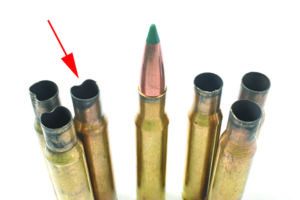
We followed a pattern that had us shoot an eight-round group of a particular ammo through the rifle with the factory gas plug installed, change the gas plug to the Garand Gear sample, shoot again, and then switch to the Schuster plug to fire a final group. In total, several hundred rounds went downrange.
The replacement plugs by Garand Gear and Schuster work by hollowing out the gas plug, thereby creating a larger expansion chamber, which lowers/varies the gas pressure inside. That alters the force impinging on the operating rod, which in turn changes the timing of and decreases the rearward speed of the op-rod. This slows down the cyclic speed of the rifle, the amount of time before the bolts unlocks, and a host of other things. How easy were the replacement plugs to use? Do they work? Did they improve anything? Are they worth buying?
Installation
All three gas plugs were simple to install and use. Screw the existing plug out using a gas-plug wrench or a large screwdriver, move to a different plug and screw back in. Total time to change plugs was measured in seconds. The Schuster plug was a bit more involved because it allows you to tune the rifle to a specific load. As with the others, remove the existing gas plug and screw in the Schuster. When we first did so and fired the rifle, the expansion chamber was wide open (on the settings as it came from the factory) and failed to cycle the rifle, leaving an empty case in the chamber. That is also what the information supplied by Schuster said would happen.
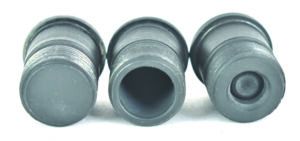
On their recommendation, we screwed an adjustment piston further into the gas plug, approximately one-quarter turn at a time, shooting for test with movement. Three-quarters of a turn and voilà! – everything was cycling and dropping empties softly on our bench. We went one more quarter turn just to make sure the rifle would cycle everything we fed it.
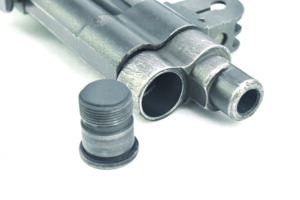
In the eventuality that the adjustment plug could come loose, a jam nut is supplied that we installed, and nothing moved for the rest of the tests. Just to remember, the Schuster allows the shooter to tune the rifle to a specific load. We did not have the ammo available to play that game and, quite possibly, were not able to get the absolute best results possible from that plug.
Function and Performance Differences
All told, we had four failures-to-feed during our tests (excepting when we first changed to the Schuster and we expected it to happen). Three of those were with the factory gas plug and a single occurrence with the Garand Gear plug, all while using the Remington factory ammunition. That made us think the malfunctions were more of an ammo issue than a gas problem. We absolutely noted a difference in the ejection pattern of the empty cases. That from the factory plug was erratic and enthusiastic. Empties would go left, right, front and back — a long way — all from the same type of ammo.
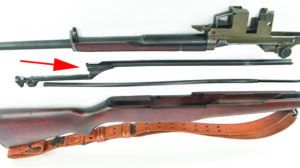
Using the replacement plugs, ejection was softer, closer to the bench and did not beat up the empty brass anywhere near as much. Without a ballistics lab we can’t tell you what the chamber pressure was for each fired round and how the different plugs affected it. We can tell you that the recoil was noticeably less while using the Garand Gear and Schuster plugs. That, along with the softer ejection, certainly leads us to believe that our new plugs would put less stress on the operating rod, allowing it to last somewhat longer than with using the factory plug.
Would the Garand Gear or Schuster plug allow the shooter to switch to any and all factory ammo not necessarily designed for a Garand? No way to tell. Perhaps it would make the rifle a bit more friendly to a greater variety of ammunition, but we found our sample rifle to be somewhat picky in what it wanted to shoot. If we got the load too hot (as judged by looking at pressure specifications from reloading manuals) for the proper operating range of an M1 (though still well within standard 30-06 pressure ranges), or if we went a little too soft, we found the changes frequently resulted in marginal accuracy as well as split case necks. We experimented with a number of different loadings and decided to stay with what the experts told us — about 49.0 grains of IMR 4895 with a CCI BR2 primer in commercial brass using a 150- to 155-grain copper-jacketed bullet. YMMV — do your own research and work up to a powder charge carefully.
Velocity Differences
We wanted to know if the replacement plugs would affect velocity. Not so much. Most of the velocities were lower, though a few were a bit higher. The maximum delta we saw was only about half of a percent. Most were in the 0.1 to 0.2% range. Would the velocities be more consistent? For the most part, yes. The standard deviation measured on the muzzle velocities were almost always better with the aftermarket plugs. With one exception, the replacement plugs generated a better standard deviation on the muzzle velocities across all loads, with the Schuster generally showing the most change. The worst to best improvement showed decreases in variations by 16% to as much as 69%. While this would have minimal affect at short range, those trying to shoot their M1’s at distance might really notice the improvement.
Accuracy Differences
And then there is accuracy. What effect would the Garand Gear and Schuster plugs have on group sizes? The Garand Gear plug won our accuracy contest with the factory plug coming in second and the Schuster last. Before you judge the Schuster too harshly, remember that plug is designed to be experimented with and we think there is a really good chance that further testing could improve the results we obtained. That being said, the groups were not that different. The Garand Gear’s best five-shot groups averaged 1.054 inch, with the factory plug averaging 1.166 inch, and the Schuster delivering 1.410 inch. Even when we included all eight shots, flyers and all, the groups for the three different plugs averaged less than 0.6 inch difference across all ammo types. The most accurate load we tested was the one using a Sierra 155-grain Match King. The factory plug won that part of the contest with a five-shot group measuring a mere 0.54 inch.
The Bottom Line
Would we buy one or both of these gas plugs after our testing? You bet! We were able to get softer recoil impulses that still functioned our rifle. Logic says that would help extend the life of the rifle. Accuracy improved in many cases and the lowered standard deviations bodes well for more consistent shots at longer ranges. We are going to keep the Garand Gear plug in our Garand for right now but, as soon as we can find some more primers, we think that the Schuster would be well worth more attention.
30-06 Springfield Range Data
To collect accuracy data, we fired various groups from a bench using a rest at 50 yards. Velocities were obtained via LabRadar (MyLabRadar.com, $559).| Remington Factory 150-grain Core-Lokt | Factory Gas Plug | Garand Gear Plug | Schuster Gas Plug |
| Average Velocity | 2857 fps. | 2847 fps. | 2839 fps |
| Velocity increase/decrease | n/a | -0.0035 | -0.0063 |
| Standard Deviation | 55.6 fps | 38.7 fps. | 41.0 fps. |
| Best 5 | 2.14 in. | 1.25 in. | 1.88 in. |
| Best 7 | 3.79 in. | 2.18 in. | 2.12 in. |
| All 8 | 4.22 in. | 3.57 in. | 3.30 in. |
| Average Group | 3.39 in. | 2.33 in. | 2.43 in. |
| Reload with 155-grain Sierra Match King | Factory Gas Plug | Garand Gear Plug | Schuster Gas Plug |
| Average Velocity | 2767 fps. | 2754 fps. | 2719 fps. |
| Velocity increase/decrease | n/a | -0.0047 | -0.0174 |
| Standard Deviation | 31.4 fps | 25.8 fps. | 12.5 fps. |
| Best 5 | 0.54 in. | 0.75 in. | 0.94 in. |
| Best 7 | 0.91 in. | 1.27 in. | 2.26 in. |
| All 8 | 2.08 in. | 1.89 in. | 3.79 in. |
| Average Group | 1.18 in. | 1.30 in. | 2.33 in. |
| Reload with 150-grain Hornady FMJ | Factory Gas Plug | Garand Gear Plug | Schuster Gas Plug |
| Average Velocity | 2775 fps. | 2772 fps. | 2780 fps. |
| Velocity increase/decrease | n/a | -0.0011 | 0.0018 |
| Standard Deviation | 39.2 fps | 24.4 fps. | 22.9 fps. |
| Best 5 | 1.03 in. | 1.39 in. | 1.74 in. |
| Best 7 | 1.64 in. | 2.42 in. | 1.90 in. |
| All 8 | 2.28 in. | 2.99 in. | 2.45 in. |
| Average Group | 1.65 in. | 2.27 in. | 2.03 in. |
| Reload with 155-grain Sierra Tipped Match King | Factory Gas Plug | Garand Gear Plug | Schuster Gas Plug |
| Average Velocity | 2823 fps. | 2856 fps. | 2867 fps. |
| Velocity increase/decrease | n/a | 0.0117 | 0.0154 |
| Standard Deviation | 18.1 fps | 23.3 fps. | 15.2 fps. |
| Best 5 | 0.96 in. | 0.83 in. | 1.08 in. |
| Best 7 | 1.84 in. | 1.55 in. | 1.98 in. |
| All 8 | 2.35 in. | 1.95 in. | 3.09 in. |
| Average Group | 1.72 in. | 1.45 in. | 2.05 in. |
Value Guide M1 Carbine, M1 Garand, M1A Rifle Rankings
| GUN NAME | ISSUE | GRADE | COMMENTS |
|---|---|---|---|
| Springfield Armory M1A SOCOM 16 AA9626 7.62 NATO/308 Win., $1799 | June 2020 | A | Our Pick. The SOCOM is short, powerful, and accurate enough for most any chore. |
| Springfield Armory M1A Scout Squad FDE AA9120 7.62 NATO/308 Win., $1455 | June 2020 | A | A reliable, hard-hitting rifle. We like the handling and trigger action as well as the reliability. |
| Federal Ordnance M1 Garand Tanker 30-06 Springfield, $775 | June 2020 | B | A great deal of fun to fire. Accurate enough for hunting to moderate range. Reliable, could be a life saver. |
| Chiappa Citadel CIR22M1W M1-22 22 LR, $300 | February 2020 | F/C | While the Chiappa looks very similar to a classic M1 Carbine, too many of the parts were made of plastic. |
| Springfield Armory Socom 16 CQB 7.62X51 AA9611, $2442 | April 2019 | B+ | Rugged and more versatile than past M1A carbines. Can be quickly adjusted to fit any shooter. |
| Israeli Arms International M1 30 Carbine, ~$480 | April 2018 | A | Light, reliable, accurate enough for combat use to 200 yards, the 30 Carbine exceeded expectation. |
| Inland Manufacturing M1 1945 Carbine 30 Carbine, $1079 | February 2017 | A- | It offered a good interpretation of the last production M1 Carbine manufactured in 1945. |
| Auto-Ordnance M1 Carbine Paratrooper AOM150 30 Carbine, $941 | February 2017 | A- | The A-O Paratrooper is easier to transport due to the folding stock, and it offered good reliability. |
| Springfield Loaded M1A MA9826 7.62 NATO, $1893 | May 2014 | B+ | The polymer stock had the slim shape and feel of original stocks. Also, it had fabulous accuracy. |
| Polytech M14S Custom 308 Win., ~$1900 | December 2010 | A | Included a chrome-lined Winchester barrel. The excellent Chinese receiver was forged. |
| Fulton Armory M14 308 Win., $2755 | December 2010 | A | The stock on the Fulton was not quite as slim and trim as the original G.I. on the custom Polytech. |
| Springfield M1A 308 Win., $1739 | December 2010 | A- | Didn’t have quite the accuracy of the Fulton M14, but was probably sufficient for most uses. |
| CMP-2 Inland Carbine 30 US Carbine, $495 | December 2009 | A+ | This was our first choice, in part because of its low price. During testing, we noted the Inland-barreled version sold out. Now we see why. |
| Fulton Armory Service Grade M1 Carbine 30 US Carbine, $1300 | December 2009 | A | Our test crew liked the Fulton Armory carbine the best, and some of us would have put up the extra money to get one. |
| CMP-1 Underwood Carbine 30 US Carbine, $565 | December 2009 | A | There were no problems nor any surprises with the Underwood-barreled carbine. |
| Auto-Ordnance AOM130 M1 Carbine 30 US Carbine, $899 | December 2009 | B- | After A-O repaired the extractor, there were no more bobbles nor failures to eject. The A-O carbine delivered fine accuracy. |
| Springfield Armory Loaded M1A MA9226 308 Win., $2363 | May 2009 | B+ | We think this rifle did a good job of handling the powerful 308 round. |
| Springfield Armory M1A AA9627 SOCOM II 308 Win., $2090 | November 2008 | A- | The SOCOM II is expensive, but you will be the boss of the block. |




























you can find an outstanding article on pressures for the Garand with “plugs” and different ammo here:
http://www.garandgear.com/m1-garand-ammunition
Is it safe to drill out a factory plug to match the depth of the other plugs
I suppose, if you’re starting with a non-poppet style solid plug and are able to drill hardened steel absolutely dead center to a perfect depth, but why bother? For $35 the Schuster high volume non-adjustable plug is already good to go, and you don’t have to worry about drilling dead center, tolerances, etc.
Note that Schuster also makes a ported non-adjustable “high volume” gas plug similar to the Garand Gear plug. I’ve bought two of them over the last few years and they work great. I already had the Schuster adjustable plug in a third rifle and wanted to stick with the Schuster brand for a non-adjustable plug.